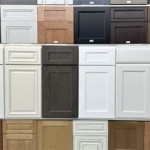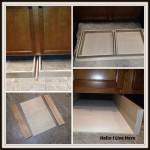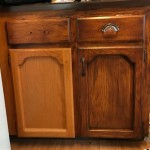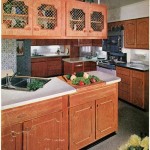How To Clean Vinyl Coated Kitchen Cabinets
Vinyl-coated kitchen cabinets are a popular choice for homeowners due to their durability, affordability, and ease of maintenance. The smooth, non-porous surface is resistant to scratches, stains, and moisture, making them ideal for high-traffic areas like kitchens. However, even with their resilience, vinyl-coated cabinets will accumulate dirt, grime, and fingerprints over time. Regular cleaning is essential to maintain their appearance and hygiene.
This article will guide you through the process of cleaning vinyl-coated kitchen cabinets effectively, ensuring they stay looking their best. It will cover the essential supplies, cleaning techniques, and recommended practices for maintaining the integrity of the vinyl coating.
Essential Supplies for Cleaning Vinyl-coated Cabinets
Before embarking on the cleaning process, gather the necessary supplies to ensure a smooth and efficient operation. The essential supplies include:
- Microfiber cloths: These soft and absorbent cloths are ideal for cleaning and drying without leaving streaks or lint. They are gentle on the vinyl surface, preventing scratches.
- Warm water: Warm water is sufficient for removing light dirt and grime.
- Mild dish soap: A mild dish soap, like Dawn or Palmolive, effectively cuts through grease and food residue without damaging the vinyl coating.
- Baking soda: Baking soda is a gentle abrasive that can effectively remove stubborn stains and grease.
- White vinegar: Vinegar possesses natural cleaning properties and can be used to disinfect surfaces and remove odors.
- Optional: A soft-bristled brush or sponge can be used to scrub away stubborn dirt or grime, but be sure to use a gentle touch.
Cleaning Techniques for Vinyl-coated Cabinets
Once the supplies are gathered, follow these steps to effectively clean your vinyl-coated kitchen cabinets:
Step 1: Dusting and Pre-Cleaning
Start by dusting the cabinets with a dry microfiber cloth to remove loose dirt and debris. This initial step will prevent dust particles from scratching the vinyl surface during subsequent cleaning.
Step 2: Warm Water Cleaning
For light dirt and grime, a warm water solution is sufficient. Dampen a microfiber cloth with warm water and wipe down the cabinet surfaces, focusing on areas that show signs of dirt. Rinse the cloth frequently to avoid spreading dirt.
Step 3: Dish Soap Cleaning
For greasy or oily areas, mix a few drops of mild dish soap with warm water. Using a clean microfiber cloth, apply the soapy solution to the affected areas and gently scrub in a circular motion. Thoroughly rinse the cloth and wipe down the cabinets again to remove any soap residue.
Step 4: Stubborn Stains and Grease
For stubborn stains and grease, create a paste of baking soda and water. Apply the paste to the affected area with a clean microfiber cloth and gently scrub in a circular motion. Allow the paste to sit for a few minutes before wiping it away with a clean, damp cloth. Rinse the area with clean water and dry thoroughly.
Step 5: Disinfecting
To disinfect the cabinets, mix a solution of equal parts white vinegar and water. Dampen a microfiber cloth with the vinegar solution and wipe down all cabinet surfaces, focusing on areas prone to bacteria, such as handles, knobs, and shelves. Allow the vinegar solution to air dry completely before using the cabinets.
Maintaining the Integrity of Vinyl-coated Cabinets
Regular cleaning is key to maintaining the appearance and longevity of your vinyl-coated kitchen cabinets. Follow these recommendations for optimal care:
- Avoid abrasive cleaners: Strong chemicals and abrasive cleaners can damage the vinyl coating, causing discoloration, scratches, and dullness. Stick to mild cleaners like dish soap and baking soda.
- Avoid excessive moisture: While vinyl is water-resistant, prolonged contact with water can lead to warping or damage. Immediately wipe away spills and avoid soaking the cabinets in water.
- Use a soft brush or sponge: For stubborn dirt or grime, use a soft-bristled brush or a non-abrasive sponge. Avoid using scouring pads or harsh brushes that can scratch the vinyl surface.
- Dry thoroughly: After cleaning, always dry the surfaces completely with a dry microfiber cloth. Leaving moisture on the cabinets can lead to water marks and bacterial growth.
- Regular cleaning: To maintain the pristine appearance of your cabinets, wipe them down with a damp cloth at least once a week. This will prevent dirt and grime from building up and becoming embedded in the vinyl.
By following these cleaning techniques and maintenance practices, you can keep your vinyl-coated kitchen cabinets looking their best for years to come. Regular cleaning will preserve the integrity of the vinyl coating, prevent scratches and stains, and ensure a hygienic kitchen environment.

How To Clean And Refinish Kitchen Cabinets Lowe S

3 Ways To Clean Laminate Cabinets Wikihow

How To Prepare And Paint Vinyl Covered Particleboard Cabinets Hunker

3 Ways To Clean Laminate Cabinets Wikihow

3 Ways To Clean Laminate Cabinets Wikihow

How To Clean Cabinets Before Painting Ultimate Guide With Pro Tips Grace In My Space

How To Clean Kitchen Cabinets Everyday Skate

How To Clean Kitchen Cabinets Pink Solution Corp

How To Clean Kitchen Cabinets 9 Basics Bob Vila

What Is Making My Kitchen Cabinet Paint L The Picky Painters Berea Oh
Related Posts








